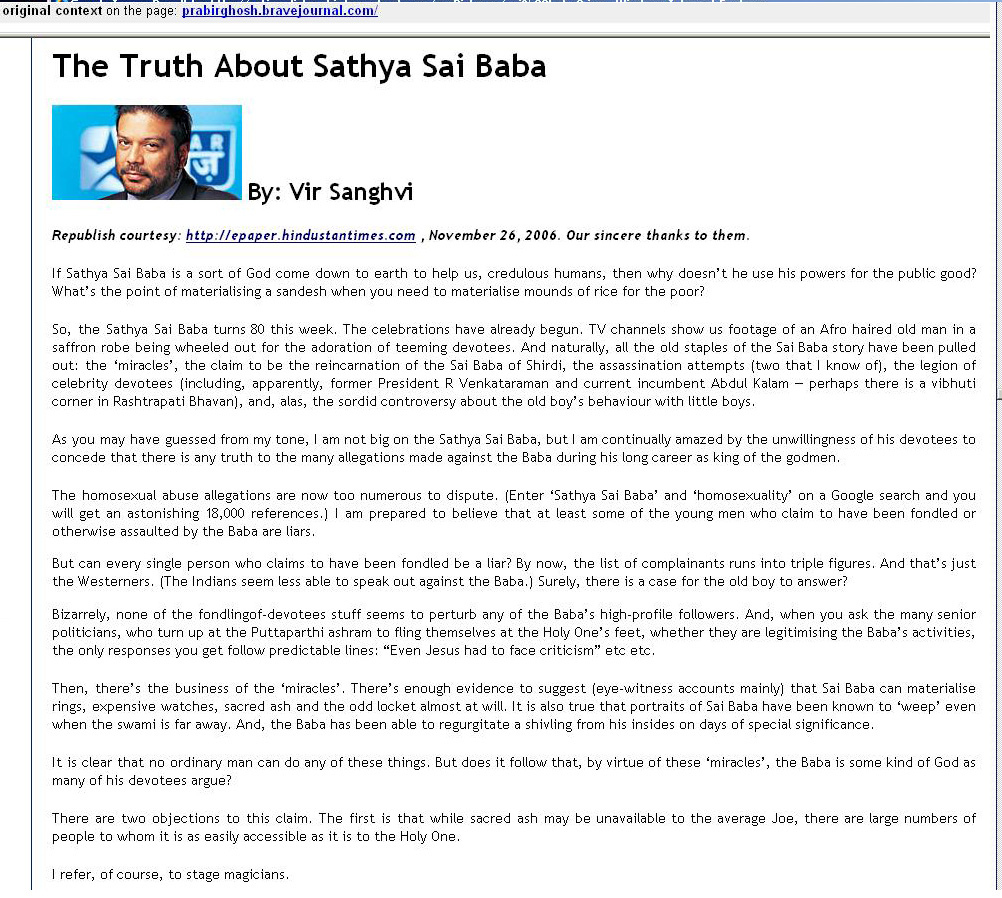| The Truth About Sathya Sai Baba Counterpoint | Vir Sanghvi November 25, 2006 |
So, the Sathya Sai Baba turns 80 this week. The celebrations have already begun. TV channels show us footage of an Afro-haired old man in a saffron robe being wheeled out for the adoration of teeming devotees. And naturally, all the old staples of the Sai Baba story have been pulled out: the ‘miracles’, the claim to be the reincarnation of the Sai Baba of Shirdi, the assassination attempts (two that I know of), the legion of celebrity devotees (including, apparently, former President R Venkataraman and current incumbent Abdul Kalam — perhaps there is a vibhuti corner in Rashtrapati Bhavan), and, alas, the sordid controversy about the old boy’s behaviour with little boys. As you may have guessed from my tone, I am not big on the Sathya Sai Baba (I have more time for the Shirdi original), but I am continually amazed by the unwillingness of his devotees to concede that there is any truth to the many allegations made against the Baba during his long career as king of the godmen. The homosexual abuse allegations are now too numerous to dispute. (Enter ‘Sathya Sai Baba’ and ‘homosexuality’ on a Google search and you will get an astonishing 18,000 references.) I am prepared to believe that at least some of the young men who claim to have been fondled or otherwise assaulted by the Baba are liars. But can every single person who claims to have been fondled be a liar? By now, the list of complainants runs into triple figures. And that’s just the Westerners. (The Indians seem less able to speak out against the Baba.) Surely, there is a case for the old boy to answer? Bizarrely, none of the fondling-of-devotees stuff seems to perturb any of the Baba’s high-profile followers. And, when you ask the many senior politicians, who turn up at the Puttaparthi ashram to fling themselves at the Holy One’s feet, whether they are legitimising the Baba’s activities, the only responses you get follow predictable lines: “Even Jesus had to face criticism” etc etc. Then, there’s the business of the ‘miracles’. There’s enough evidence to suggest (eye-witness accounts mainly) that Sai Baba can materialise rings, expensive watches, sacred ash and the odd locket almost at will. It is also true that portraits of Sai Baba have been known to ‘weep’ even when the swami is far away. And, the Baba has been able to regurgitate a shivling from his insides on days of special significance. It is clear that no ordinary man can do any of these things. But does it follow that, by virtue of these ‘miracles’, the Baba is some kind of God as many of his devotees argue? There are two objections to this claim. The first is that while sacred ash may be unavailable to the average Joe, there are large numbers of people to whom it is as easily accessible as it is to the Holy One. I refer, of course, to stage magicians. The sad reality of the Sai Baba’s ‘miracles’ is that every single one of them can easily be duplicated by even a moderately-talented conjuror. In the old days (dating back to the 1960s), when scepticism was first expressed about Sai Baba’s ‘magic’ powers, critics asked why it was that the watches he produced, seemingly out of thin air, all said ‘Made in Switzerland’ and why they tended to be much advertised brands. (Rich devotees got Omegas, the poor just got sacred ash.) Sai Baba’s defenders retorted that the great man had never claimed to be a holy watchmaker. His skill did not lie in creating watches or rings. These already existed. All the Baba did was to invisibly teleport them through solid matter till they reached his sacred fingers. Problem: this is exactly what magicians claim to do. No magician claims to have created the rabbit that emerges from the hat. He claims to have teleported it. And so, what is so special about a man whose tricks are roughly on par with K Lal but well below the standard of David Blaine or David Copperfield? Sai Baba devotees are sensitive to the ‘Afro-haired conjuror’ sneer. Over a decade ago, the magician PC Sorcar was refused entry into Sai Baba’s presence. He went under a false name and when the Baba miraculously produced a sandesh, Sorcar returned the compliment by miraculously producing a rasgulla. The Baba began shouting and Sorcar was physically evicted from the ashram. The magician wrote about the encounter in Sunday magazine. But since then, he has come under so much pressure from the Sai Baba lobby that he’s reluctant to repeat the experience. No matter. There are enough people who can do the same tricks. Sanal Edamaraku of the Indian Rationalist Association, who does not even claim to be a magician, will cheerfully reproduce any of the old boy’s ‘miracles’ on demand. The second objection to the Baba’s ‘miracles’ is also fundamental. His devotees now take the revised position that the Omega watches are merely his ‘calling cards’ meant to show ordinary mortals how cosmic he is. The real God-like stuff, they say, consists of the Baba’s ability to see into the future, to change destiny and to heal the human body. All this is highly dubious. If he can heal other people, then why doesn’t he just heal himself first, and kick away that wheelchair? If he can see into the future, how come he failed to predict the two assassination attempts? And if he can change destiny, why doesn’t he start by changing that Google search that portrays him as a bit of a sicko? I am familiar with all the arguments against my position. There’s the traditional one of how the Baba does not want to interfere with the karmic cycle of good and evil. Well, in that case, he should stop pretending that he can heal people and remove karmic sickness. The moment he bends the laws of nature, he is already mucking about with the karmic cycle anyway. Then, there’s the he-does-so-much-charity argument. I do not for a moment dispute that he spends many of the crores his devotees shower on him for very good causes. And I accept that he has built hospitals, colleges (and, incongruously enough, a planetarium) for the people of Puttaparthi. But all that this proves is that he’s a philanthropist of some description. Nor is religious philanthropy novel to Hinduism. The Ramakrishna Mission does much more than the Sai Baba has ever done or ever will. (Actually, it’s done more work in Calcutta than Mother Teresa’s better-publicised missionaries — but that’s another story.) However, none of its monks claims to be God. And they don’t need to produce Omega watches out of thin air. They are too busy helping the poor. But, my basic objection is this: if this man is a sort of God come down to earth to help us, credulous humans, then why doesn’t he use his powers for the public good? What’s the point of materialising a sandesh when you need to materialise mounds of rice for the poor? Why bother giving some crooked politician an Omega watch when you can stop the Tsunami? Why do these God-like powers never extend to any more than mere conjuring tricks? Why do they never translate into anything that is substantial and truly helpful? If this is the best that God can do, then surely PC Sorcar is God too? |

